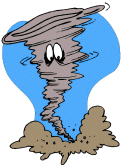
Tornadoes
 A tornado is defined as a violently rotating column of air in contact with the ground that originated from the base of a cumulonimbus cloud. They can be highly destructive but fortunately are relatively small in comparison to other extreme weather phenomena such as thunderstorms and hurricanes. The tornado can be seen by the rapid rotation of cloud caught up within it. Tornadoes are also known popularly as "twisters". Tornadoes are particularly common in the central United States.
A tornado is defined as a violently rotating column of air in contact with the ground that originated from the base of a cumulonimbus cloud. They can be highly destructive but fortunately are relatively small in comparison to other extreme weather phenomena such as thunderstorms and hurricanes. The tornado can be seen by the rapid rotation of cloud caught up within it. Tornadoes are also known popularly as "twisters". Tornadoes are particularly common in the central United States.
Tornadoes can be categorised as "weak", "strong", and "violent". Weak tornadoes, making up about 70% of all tornadoes, often have a thin, rope-like appearance. Rotating wind speeds are no greater than about 110 mph. "Strong" tornadoes, making up nearly 30% of all tornadoes, often exhibit the more "classic" funnel-shaped cloud associated with the whirling air column. Rotating wind speeds vary from 110 to 200 mph. The most violent tornadoes are relatively rare, making up only 2% of all tornado cases. Rotating wind speeds in "violent" tornadoes can approach speeds close to 300 mph.
Most tornadoes form in the presence of thunderstorms. All thunderstorms are characterised by rising or convecting air, called updrafts. These updrafts supply the warm, humid air that fuels thunderstorms. In some cases, the column of rising air becomes a vortex - a funnel cloud or tornado. Often, a tornado is located on the edge of the updraft, adjacent to the thunderstorm downdraft that accompanies the falling rain or precipitation. Meteorologists however, still do not fully understand why updrafts in some thunderstorms become tornadoes while those in apparently similar thunderstorms do not.
The center of the tornado's vortex is a low-pressure area. Inside the vortex, atmospheric pressure may fall as low as 500 millibars, or half the normal value. The depressurisation of the vortex cools the air which is rushing in, allowing the condensation of water vapour to form the tornado's familiar funnel-shaped cloud. As the swirling winds pick up dust, dirt, and debris from the ground, the funnel may become even darker.
Although the air is rising in a tornado, the funnel itself grows from the cloud above downwards toward the ground as the tornado is forming. The term "funnel cloud'' refers to a tornado-like vortex that doesn't reach the ground. When a funnel cloud touches the ground, it becomes a tornado.
Websites
Other topics
• NOAA
• US Weather Service
• Tornado
• Tornado Strength
• USA Today
• Franklin Institute
• Tornado Chase Day
• Introduction to Weather
• Anticyclones
• Beaufort Scale
• Cirrus Clouds
• Clouds
• Cold Fronts
• Condensation
• Convection
• Cooling Air
• Cumulonimbus Clouds
• Cumulus Clouds
• Depressions
• Dew
• Dew Point
• Energy
• Evaporation
• Fog
• Forecasting
• Fronts
• Frost
• Humidity
• Hurricanes
• Isobars
• Measuring Weather
• Meteorology
• Monsoons
• Movement of Air
• Occluded Fronts
• Precipitation
• Pressure
• Sea Breeze
• Stability of Air
• Stratus Clouds
• Sunshine
• Synoptic Charts
• Temperature
• Thunderstorms
• Tornadoes
• Uplift of Air
• Warm Fronts
• Water Cycle
• Weather Symbols
• Wind
 Print Topic
Print Topic